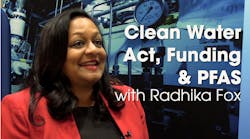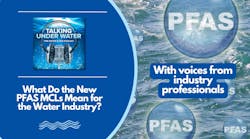The U.S. Environmental Protection Agency (EPA) announced it has achieved improvement in compliance with Clean Water Act (CWA) permits over the past five-year period.
In FY 2018, EPA and 47 states agreed to collaborate on a goal to reduce significant noncompliance among facilities permitted under the Clean Water Act by 50% over five years. EPA announced this collaborative effort has achieved its goal – the national significant non-compliance (SNC) rate has been reduced from 20.3% at the start of 2018 to 9% today. This reduction in violations advances EPA’s strategic plan goal to ensure clean and safe water for all communities. This improvement in CWA compliance will produce substantial benefits for public health and the environment.
“Five years ago, EPA set an ambitious goal for cutting the rate of significant noncompliance with Clean Water Act permits in half,” said Larry Starfield, acting assistant administrator for EPA’s Office of Enforcement and Compliance Assurance. “Today I’m pleased to announce that we have met and exceeded that target achieving a historically low rate of 9 percent. This notable achievement speaks to what EPA and the states can accomplish together to improve compliance and reduce Clean Water Act violations.”
For decades prior to this initiative, over 20% of CWA individually permitted facilities had “significant non-compliance” (SNC) level violations with their water discharge permit, including violations for exceeding permitted pollutant discharge limits, not meeting enforcement order or permit requirements, and not timely reporting compliance data or sometimes at all. In response to these persistent CWA non-compliance problems, EPA in 2018 set a goal to cut the level of SNC violations at roughly 46,000 CWA regulated facilities in half over 5 years.
EPA immediately reached out to the states to partner with them in this effort and to find ways to achieve the goal together. In 2020, EPA took another step and made this effort one of the EPA enforcement program’s National Compliance Initiatives (NCIs).
“Virginia is honored to have been invited to serve as the state co-chair of this initiative. Over the long term, Virginia has achieved a low rate of SNC, and we are pleased to provide leadership in this area,” said Travis Voyles, Virginia acting secretary of natural and historic resources. “This initiative is a tremendous example of the importance of an effective partnership between EPA and the states.”
“DEC applauds EPA’s development of effective tools that are enhancing New York’s sustained regulatory efforts and bringing facilities into full compliance with stringent federal and state clean water standards,” said New York State Department of Environmental Conservation Commissioner Basil Seggos. “New York continues to be a leader in national compliance efforts and in collaborating with our federal partners on compliance initiatives, sharing our expertise in overseeing thousands of facilities to help make meaningful progress in improving water quality, holding polluters accountable, and benefitting communities across New York State and the U.S.”
Achieving a 50% cut in the rate of facilities with SNC level CWA violations improves public health and the environment by:
- Reducing the number of permitted facilities with SNC-level violations by roughly 4,000 fewer facilities.
- Reducing the amount of illegal discharges of water pollution by 23.7 million pounds through enforcement cases concluded over the past three years.
- Creating lasting, strong, reliable EPA/state partnerships which can be mobilized to achieve additional successes.
- Assuring EPA and states have a complete compliance data set to allow quick recognition of and proactive response to CWA non-compliance.
- Increasing attention on the remaining non-compliant facilities and, in turn, increasing the level of compliance across all CWA permittees.
Improvements to Discharge Pollutant Monitoring Data
Underlying this achievement is EPA’s 2015 CWA rule that requires all facilities to electronically report water discharge pollutant monitoring data to EPA and the states. Prior to this effort, EPA was unable to determine compliance and calculate a reliable rate for SNC for the full 46,000 CWA permitted facilities due to a lack of consistent or accurate data reporting.
As a result, improving the completeness of the data became a key focus of the initiative to assure that EPA could accurately determine noncompliance and the SNC rate. Access to electronic data on compliance by the universe of regulated parties is not available under most environmental programs.
EPA now has accurate data for determining compliance for CWA facilities for about 96% of CWA individually permitted facilities for almost every state in the country. Now, EPA and states can clearly see which facilities are in violation of their permit and prioritize these violators for notification, compliance assistance, financial assistance, or enforcement to assure that public health and the environment are protected.
Additionally, data improvement increases public transparency, helping communities understand what pollutants are being discharged into local waterways and where violations are occurring.
How EPA Achieved It
Contributing to the success of this initiative were strong EPA-state partnerships and a close working partnership with the Association of Clean Water Administrators (ACWA). EPA met with individual states more than 600 times to discuss strategies for reducing SNC and how to address specific SNC violators.
ACWA supported the initiative from its inception, providing leadership and advice, and played a key role in obtaining input from states to plot a collaborative path to success.
In 2023, EPA and the states will continue to focus on assuring that the progress gained is not lost and on addressing the worst CWA violators across the country.
Additional Resources
- More information about EPA’s National Compliance Initiatives.
- More information about the National Compliance Initiative for “Reducing Significant Non-Compliance with National Pollutant Discharge Elimination System (NPDES) Permits.”
- More information about the FY 2022 – FY 2026 EPA Strategic Plan.
Source: U.S. EPA Press Release




